Exploring Leadership Across Cultures: Styles, Impact & Dimensions
VerifiedAdded on 2023/04/21
|20
|5378
|109
Report
AI Summary
This report examines leadership across different cultures, emphasizing the importance of understanding various leadership styles and cultural dimensions in multinational organizations. It highlights the need for leaders to adapt their approaches based on cultural differences, referencing Hofstede's cultural dimensions framework to illustrate variations between countries like Canada and Singapore. The report discusses different leadership styles such as democratic, autocratic, transformational, and transactional, and their effectiveness in diverse cultural contexts. It emphasizes that successful leaders must possess qualities like vision, integrity, and adaptability, adjusting their styles to suit the specific needs of their teams and organizational situations, while also considering factors such as cultural differences, time constraints, and interpersonal relationships.
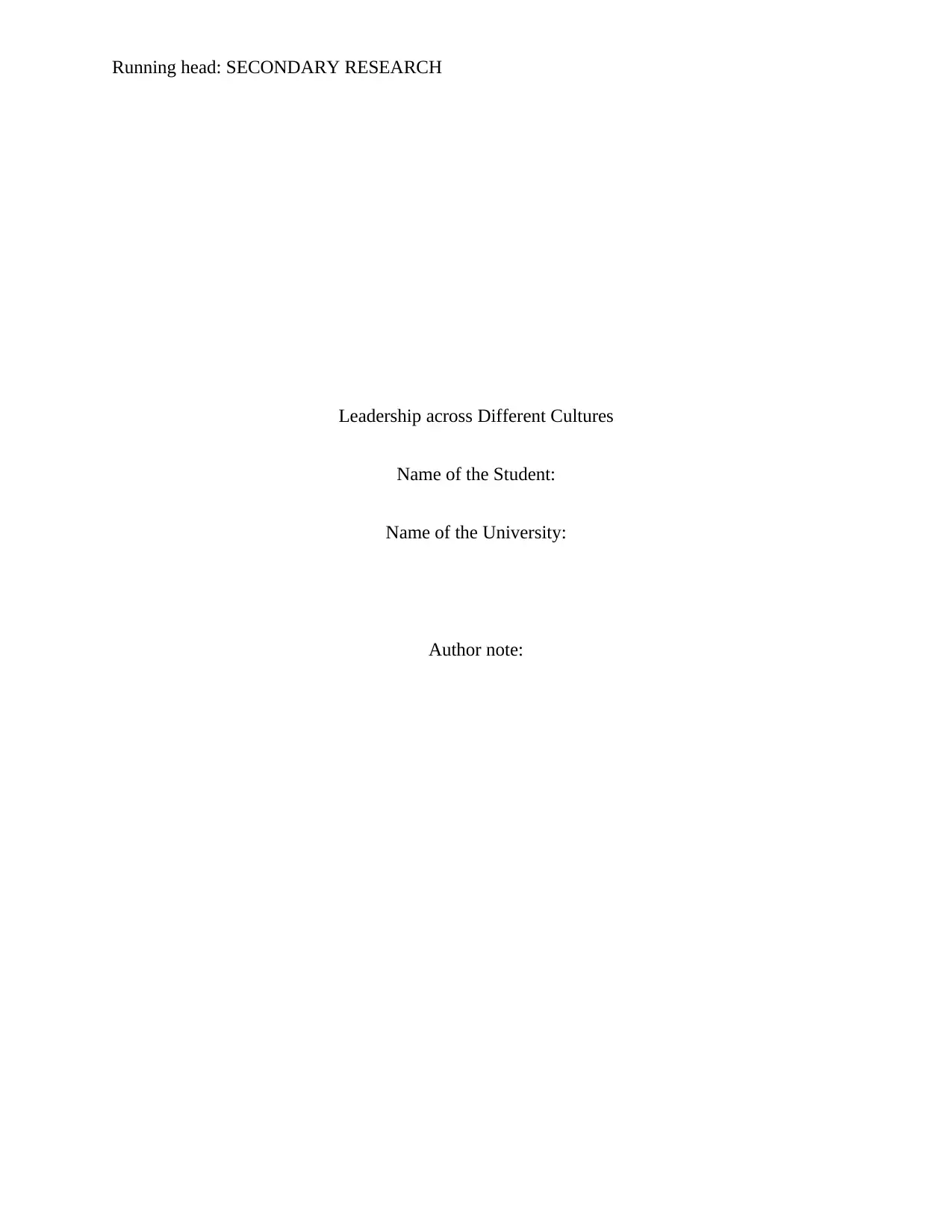
Running head: SECONDARY RESEARCH
Leadership across Different Cultures
Name of the Student:
Name of the University:
Author note:
Leadership across Different Cultures
Name of the Student:
Name of the University:
Author note:
Paraphrase This Document
Need a fresh take? Get an instant paraphrase of this document with our AI Paraphraser
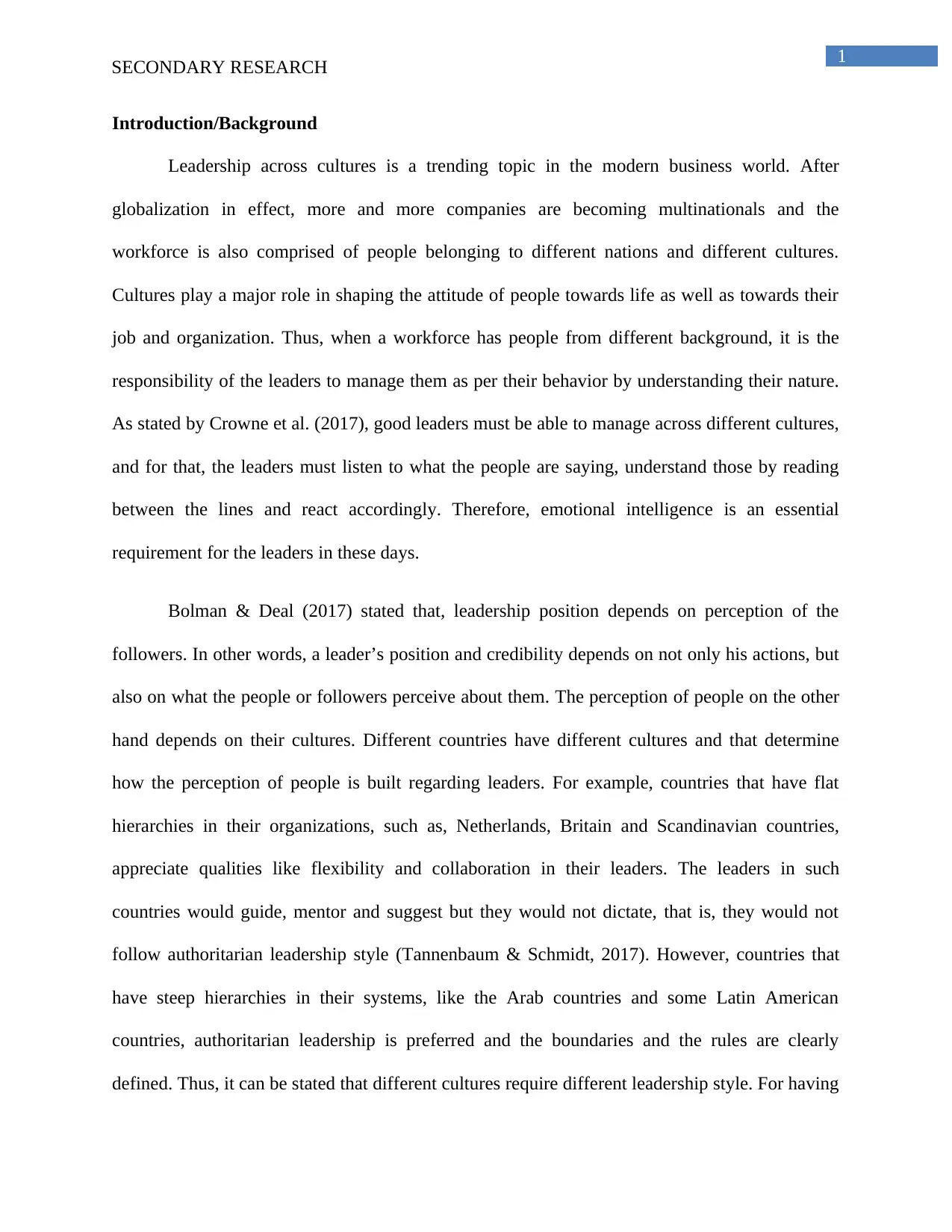
1
SECONDARY RESEARCH
Introduction/Background
Leadership across cultures is a trending topic in the modern business world. After
globalization in effect, more and more companies are becoming multinationals and the
workforce is also comprised of people belonging to different nations and different cultures.
Cultures play a major role in shaping the attitude of people towards life as well as towards their
job and organization. Thus, when a workforce has people from different background, it is the
responsibility of the leaders to manage them as per their behavior by understanding their nature.
As stated by Crowne et al. (2017), good leaders must be able to manage across different cultures,
and for that, the leaders must listen to what the people are saying, understand those by reading
between the lines and react accordingly. Therefore, emotional intelligence is an essential
requirement for the leaders in these days.
Bolman & Deal (2017) stated that, leadership position depends on perception of the
followers. In other words, a leader’s position and credibility depends on not only his actions, but
also on what the people or followers perceive about them. The perception of people on the other
hand depends on their cultures. Different countries have different cultures and that determine
how the perception of people is built regarding leaders. For example, countries that have flat
hierarchies in their organizations, such as, Netherlands, Britain and Scandinavian countries,
appreciate qualities like flexibility and collaboration in their leaders. The leaders in such
countries would guide, mentor and suggest but they would not dictate, that is, they would not
follow authoritarian leadership style (Tannenbaum & Schmidt, 2017). However, countries that
have steep hierarchies in their systems, like the Arab countries and some Latin American
countries, authoritarian leadership is preferred and the boundaries and the rules are clearly
defined. Thus, it can be stated that different cultures require different leadership style. For having
SECONDARY RESEARCH
Introduction/Background
Leadership across cultures is a trending topic in the modern business world. After
globalization in effect, more and more companies are becoming multinationals and the
workforce is also comprised of people belonging to different nations and different cultures.
Cultures play a major role in shaping the attitude of people towards life as well as towards their
job and organization. Thus, when a workforce has people from different background, it is the
responsibility of the leaders to manage them as per their behavior by understanding their nature.
As stated by Crowne et al. (2017), good leaders must be able to manage across different cultures,
and for that, the leaders must listen to what the people are saying, understand those by reading
between the lines and react accordingly. Therefore, emotional intelligence is an essential
requirement for the leaders in these days.
Bolman & Deal (2017) stated that, leadership position depends on perception of the
followers. In other words, a leader’s position and credibility depends on not only his actions, but
also on what the people or followers perceive about them. The perception of people on the other
hand depends on their cultures. Different countries have different cultures and that determine
how the perception of people is built regarding leaders. For example, countries that have flat
hierarchies in their organizations, such as, Netherlands, Britain and Scandinavian countries,
appreciate qualities like flexibility and collaboration in their leaders. The leaders in such
countries would guide, mentor and suggest but they would not dictate, that is, they would not
follow authoritarian leadership style (Tannenbaum & Schmidt, 2017). However, countries that
have steep hierarchies in their systems, like the Arab countries and some Latin American
countries, authoritarian leadership is preferred and the boundaries and the rules are clearly
defined. Thus, it can be stated that different cultures require different leadership style. For having
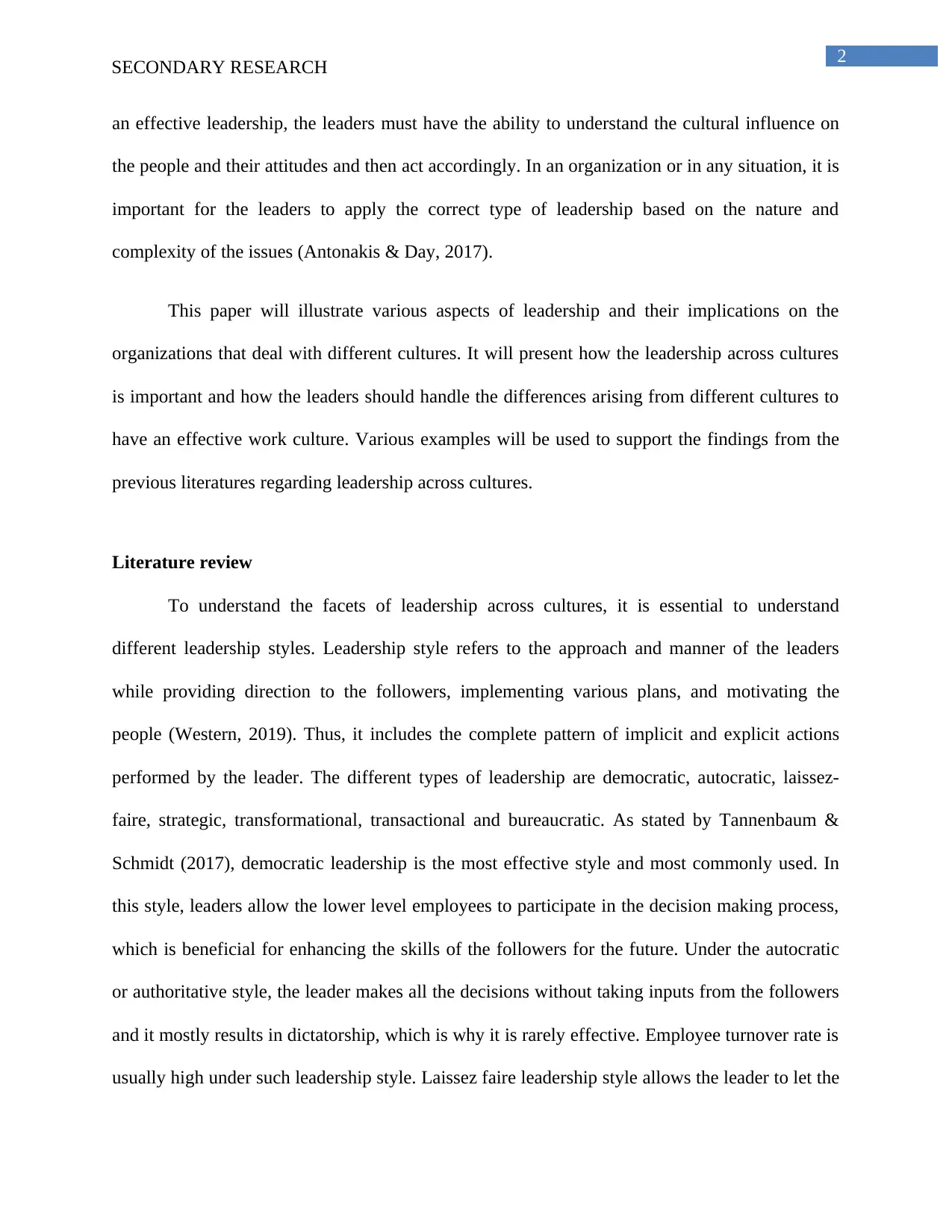
2
SECONDARY RESEARCH
an effective leadership, the leaders must have the ability to understand the cultural influence on
the people and their attitudes and then act accordingly. In an organization or in any situation, it is
important for the leaders to apply the correct type of leadership based on the nature and
complexity of the issues (Antonakis & Day, 2017).
This paper will illustrate various aspects of leadership and their implications on the
organizations that deal with different cultures. It will present how the leadership across cultures
is important and how the leaders should handle the differences arising from different cultures to
have an effective work culture. Various examples will be used to support the findings from the
previous literatures regarding leadership across cultures.
Literature review
To understand the facets of leadership across cultures, it is essential to understand
different leadership styles. Leadership style refers to the approach and manner of the leaders
while providing direction to the followers, implementing various plans, and motivating the
people (Western, 2019). Thus, it includes the complete pattern of implicit and explicit actions
performed by the leader. The different types of leadership are democratic, autocratic, laissez-
faire, strategic, transformational, transactional and bureaucratic. As stated by Tannenbaum &
Schmidt (2017), democratic leadership is the most effective style and most commonly used. In
this style, leaders allow the lower level employees to participate in the decision making process,
which is beneficial for enhancing the skills of the followers for the future. Under the autocratic
or authoritative style, the leader makes all the decisions without taking inputs from the followers
and it mostly results in dictatorship, which is why it is rarely effective. Employee turnover rate is
usually high under such leadership style. Laissez faire leadership style allows the leader to let the
SECONDARY RESEARCH
an effective leadership, the leaders must have the ability to understand the cultural influence on
the people and their attitudes and then act accordingly. In an organization or in any situation, it is
important for the leaders to apply the correct type of leadership based on the nature and
complexity of the issues (Antonakis & Day, 2017).
This paper will illustrate various aspects of leadership and their implications on the
organizations that deal with different cultures. It will present how the leadership across cultures
is important and how the leaders should handle the differences arising from different cultures to
have an effective work culture. Various examples will be used to support the findings from the
previous literatures regarding leadership across cultures.
Literature review
To understand the facets of leadership across cultures, it is essential to understand
different leadership styles. Leadership style refers to the approach and manner of the leaders
while providing direction to the followers, implementing various plans, and motivating the
people (Western, 2019). Thus, it includes the complete pattern of implicit and explicit actions
performed by the leader. The different types of leadership are democratic, autocratic, laissez-
faire, strategic, transformational, transactional and bureaucratic. As stated by Tannenbaum &
Schmidt (2017), democratic leadership is the most effective style and most commonly used. In
this style, leaders allow the lower level employees to participate in the decision making process,
which is beneficial for enhancing the skills of the followers for the future. Under the autocratic
or authoritative style, the leader makes all the decisions without taking inputs from the followers
and it mostly results in dictatorship, which is why it is rarely effective. Employee turnover rate is
usually high under such leadership style. Laissez faire leadership style allows the leader to let the
⊘ This is a preview!⊘
Do you want full access?
Subscribe today to unlock all pages.

Trusted by 1+ million students worldwide
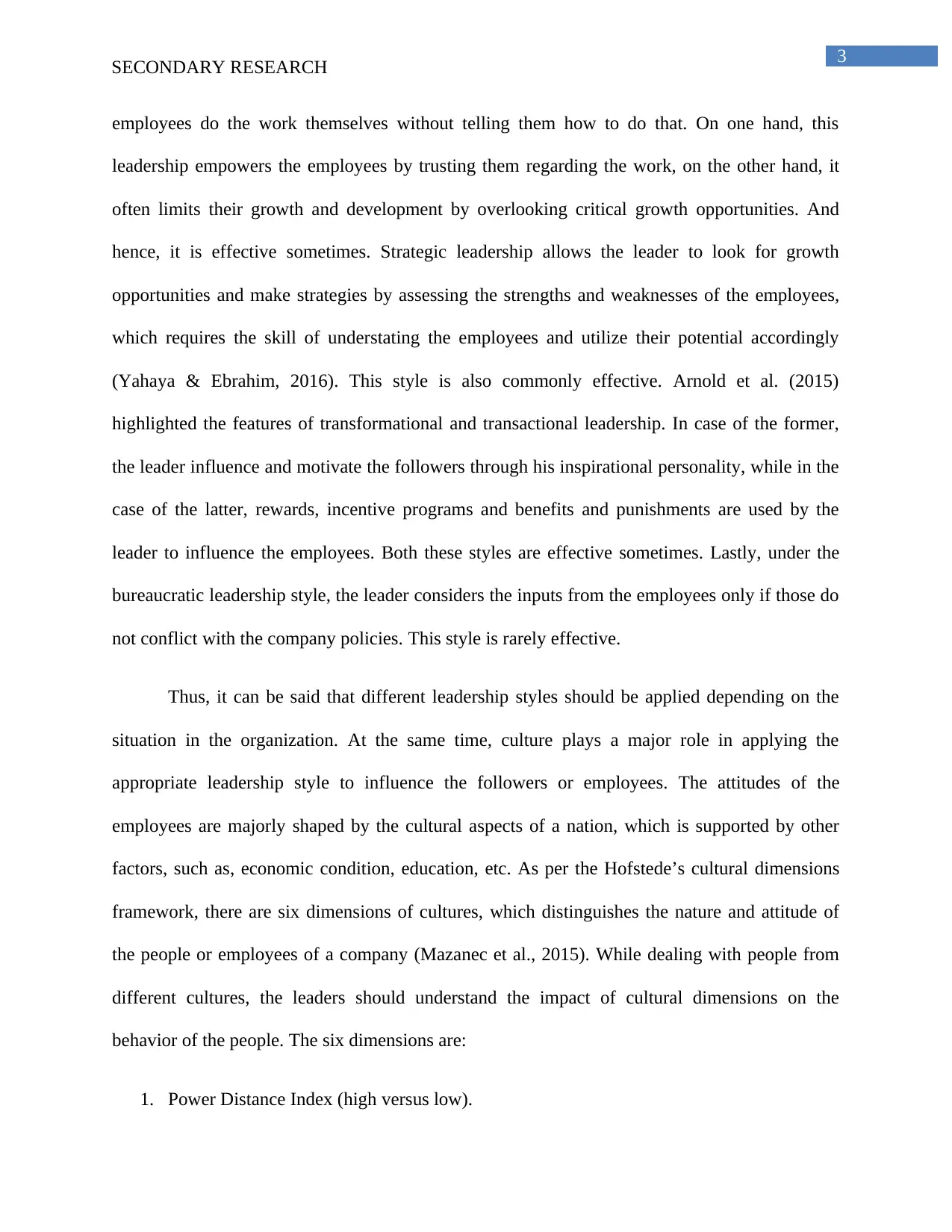
3
SECONDARY RESEARCH
employees do the work themselves without telling them how to do that. On one hand, this
leadership empowers the employees by trusting them regarding the work, on the other hand, it
often limits their growth and development by overlooking critical growth opportunities. And
hence, it is effective sometimes. Strategic leadership allows the leader to look for growth
opportunities and make strategies by assessing the strengths and weaknesses of the employees,
which requires the skill of understating the employees and utilize their potential accordingly
(Yahaya & Ebrahim, 2016). This style is also commonly effective. Arnold et al. (2015)
highlighted the features of transformational and transactional leadership. In case of the former,
the leader influence and motivate the followers through his inspirational personality, while in the
case of the latter, rewards, incentive programs and benefits and punishments are used by the
leader to influence the employees. Both these styles are effective sometimes. Lastly, under the
bureaucratic leadership style, the leader considers the inputs from the employees only if those do
not conflict with the company policies. This style is rarely effective.
Thus, it can be said that different leadership styles should be applied depending on the
situation in the organization. At the same time, culture plays a major role in applying the
appropriate leadership style to influence the followers or employees. The attitudes of the
employees are majorly shaped by the cultural aspects of a nation, which is supported by other
factors, such as, economic condition, education, etc. As per the Hofstede’s cultural dimensions
framework, there are six dimensions of cultures, which distinguishes the nature and attitude of
the people or employees of a company (Mazanec et al., 2015). While dealing with people from
different cultures, the leaders should understand the impact of cultural dimensions on the
behavior of the people. The six dimensions are:
1. Power Distance Index (high versus low).
SECONDARY RESEARCH
employees do the work themselves without telling them how to do that. On one hand, this
leadership empowers the employees by trusting them regarding the work, on the other hand, it
often limits their growth and development by overlooking critical growth opportunities. And
hence, it is effective sometimes. Strategic leadership allows the leader to look for growth
opportunities and make strategies by assessing the strengths and weaknesses of the employees,
which requires the skill of understating the employees and utilize their potential accordingly
(Yahaya & Ebrahim, 2016). This style is also commonly effective. Arnold et al. (2015)
highlighted the features of transformational and transactional leadership. In case of the former,
the leader influence and motivate the followers through his inspirational personality, while in the
case of the latter, rewards, incentive programs and benefits and punishments are used by the
leader to influence the employees. Both these styles are effective sometimes. Lastly, under the
bureaucratic leadership style, the leader considers the inputs from the employees only if those do
not conflict with the company policies. This style is rarely effective.
Thus, it can be said that different leadership styles should be applied depending on the
situation in the organization. At the same time, culture plays a major role in applying the
appropriate leadership style to influence the followers or employees. The attitudes of the
employees are majorly shaped by the cultural aspects of a nation, which is supported by other
factors, such as, economic condition, education, etc. As per the Hofstede’s cultural dimensions
framework, there are six dimensions of cultures, which distinguishes the nature and attitude of
the people or employees of a company (Mazanec et al., 2015). While dealing with people from
different cultures, the leaders should understand the impact of cultural dimensions on the
behavior of the people. The six dimensions are:
1. Power Distance Index (high versus low).
Paraphrase This Document
Need a fresh take? Get an instant paraphrase of this document with our AI Paraphraser
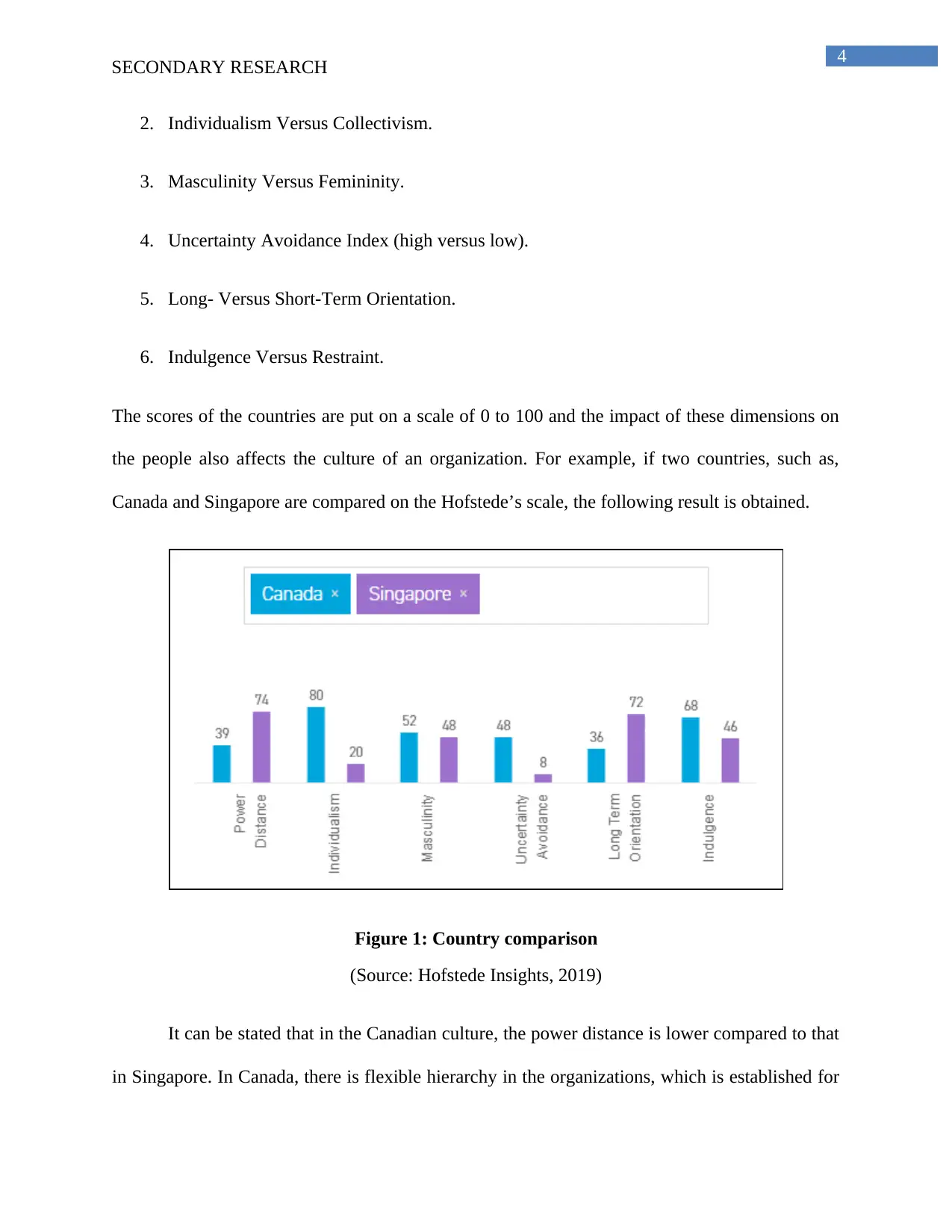
4
SECONDARY RESEARCH
2. Individualism Versus Collectivism.
3. Masculinity Versus Femininity.
4. Uncertainty Avoidance Index (high versus low).
5. Long- Versus Short-Term Orientation.
6. Indulgence Versus Restraint.
The scores of the countries are put on a scale of 0 to 100 and the impact of these dimensions on
the people also affects the culture of an organization. For example, if two countries, such as,
Canada and Singapore are compared on the Hofstede’s scale, the following result is obtained.
Figure 1: Country comparison
(Source: Hofstede Insights, 2019)
It can be stated that in the Canadian culture, the power distance is lower compared to that
in Singapore. In Canada, there is flexible hierarchy in the organizations, which is established for
SECONDARY RESEARCH
2. Individualism Versus Collectivism.
3. Masculinity Versus Femininity.
4. Uncertainty Avoidance Index (high versus low).
5. Long- Versus Short-Term Orientation.
6. Indulgence Versus Restraint.
The scores of the countries are put on a scale of 0 to 100 and the impact of these dimensions on
the people also affects the culture of an organization. For example, if two countries, such as,
Canada and Singapore are compared on the Hofstede’s scale, the following result is obtained.
Figure 1: Country comparison
(Source: Hofstede Insights, 2019)
It can be stated that in the Canadian culture, the power distance is lower compared to that
in Singapore. In Canada, there is flexible hierarchy in the organizations, which is established for
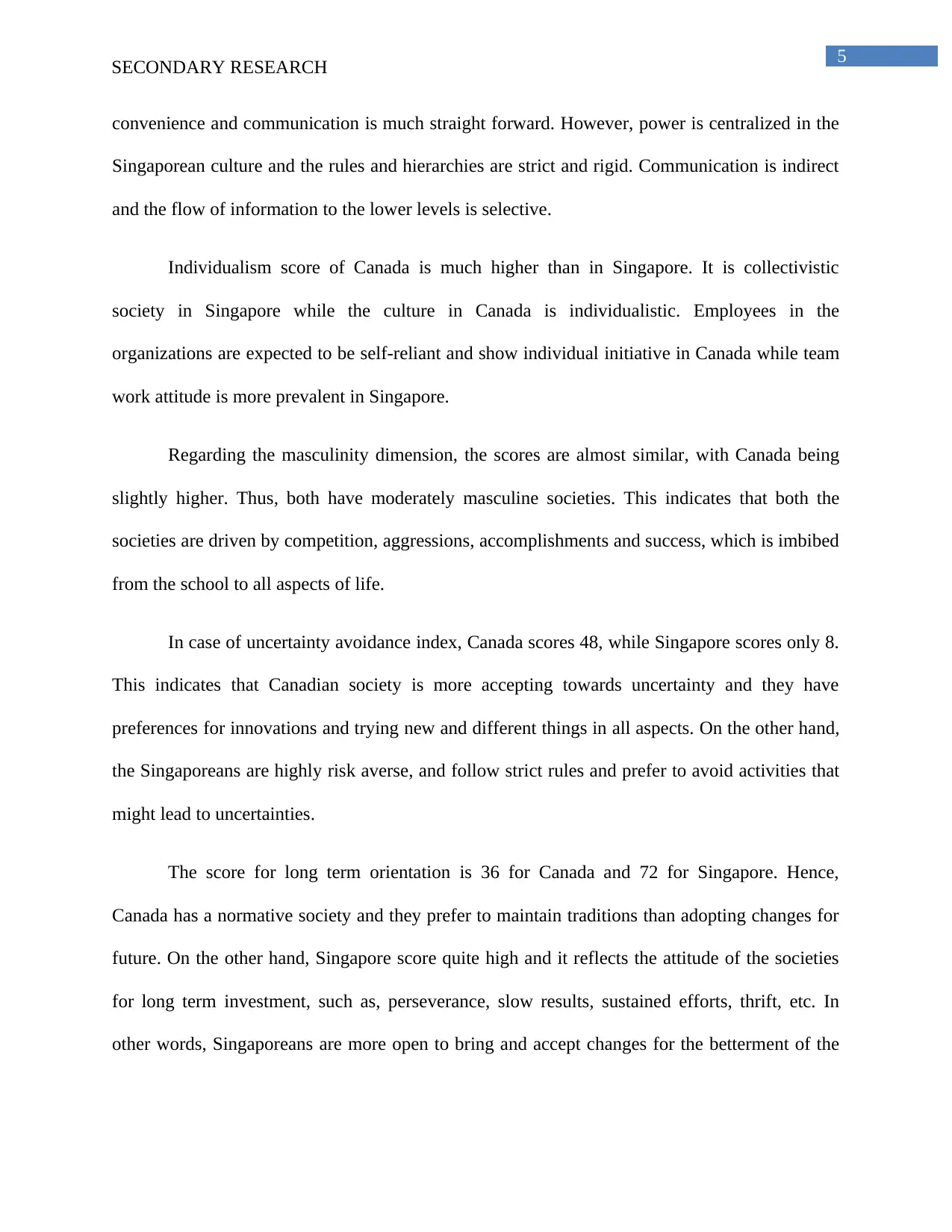
5
SECONDARY RESEARCH
convenience and communication is much straight forward. However, power is centralized in the
Singaporean culture and the rules and hierarchies are strict and rigid. Communication is indirect
and the flow of information to the lower levels is selective.
Individualism score of Canada is much higher than in Singapore. It is collectivistic
society in Singapore while the culture in Canada is individualistic. Employees in the
organizations are expected to be self-reliant and show individual initiative in Canada while team
work attitude is more prevalent in Singapore.
Regarding the masculinity dimension, the scores are almost similar, with Canada being
slightly higher. Thus, both have moderately masculine societies. This indicates that both the
societies are driven by competition, aggressions, accomplishments and success, which is imbibed
from the school to all aspects of life.
In case of uncertainty avoidance index, Canada scores 48, while Singapore scores only 8.
This indicates that Canadian society is more accepting towards uncertainty and they have
preferences for innovations and trying new and different things in all aspects. On the other hand,
the Singaporeans are highly risk averse, and follow strict rules and prefer to avoid activities that
might lead to uncertainties.
The score for long term orientation is 36 for Canada and 72 for Singapore. Hence,
Canada has a normative society and they prefer to maintain traditions than adopting changes for
future. On the other hand, Singapore score quite high and it reflects the attitude of the societies
for long term investment, such as, perseverance, slow results, sustained efforts, thrift, etc. In
other words, Singaporeans are more open to bring and accept changes for the betterment of the
SECONDARY RESEARCH
convenience and communication is much straight forward. However, power is centralized in the
Singaporean culture and the rules and hierarchies are strict and rigid. Communication is indirect
and the flow of information to the lower levels is selective.
Individualism score of Canada is much higher than in Singapore. It is collectivistic
society in Singapore while the culture in Canada is individualistic. Employees in the
organizations are expected to be self-reliant and show individual initiative in Canada while team
work attitude is more prevalent in Singapore.
Regarding the masculinity dimension, the scores are almost similar, with Canada being
slightly higher. Thus, both have moderately masculine societies. This indicates that both the
societies are driven by competition, aggressions, accomplishments and success, which is imbibed
from the school to all aspects of life.
In case of uncertainty avoidance index, Canada scores 48, while Singapore scores only 8.
This indicates that Canadian society is more accepting towards uncertainty and they have
preferences for innovations and trying new and different things in all aspects. On the other hand,
the Singaporeans are highly risk averse, and follow strict rules and prefer to avoid activities that
might lead to uncertainties.
The score for long term orientation is 36 for Canada and 72 for Singapore. Hence,
Canada has a normative society and they prefer to maintain traditions than adopting changes for
future. On the other hand, Singapore score quite high and it reflects the attitude of the societies
for long term investment, such as, perseverance, slow results, sustained efforts, thrift, etc. In
other words, Singaporeans are more open to bring and accept changes for the betterment of the
⊘ This is a preview!⊘
Do you want full access?
Subscribe today to unlock all pages.

Trusted by 1+ million students worldwide
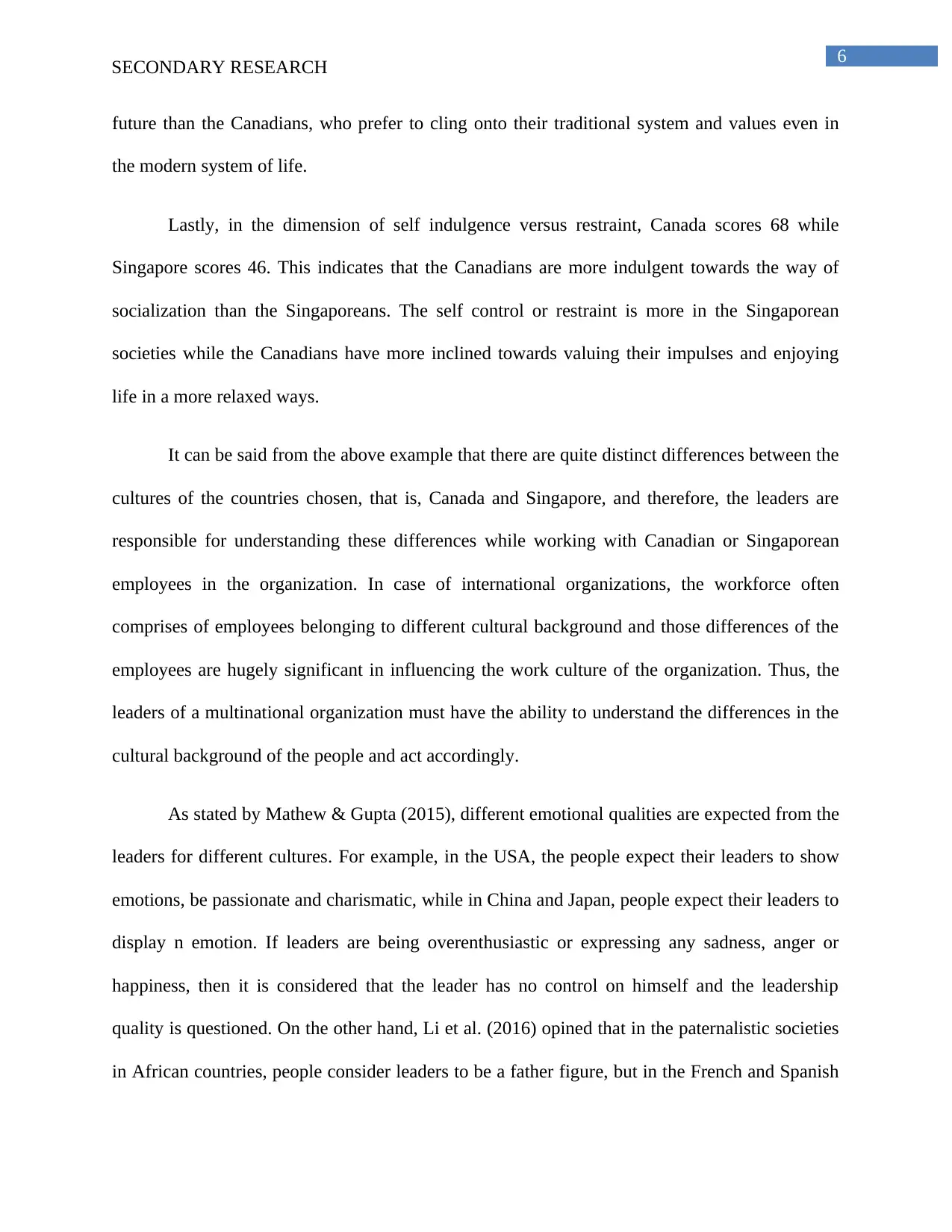
6
SECONDARY RESEARCH
future than the Canadians, who prefer to cling onto their traditional system and values even in
the modern system of life.
Lastly, in the dimension of self indulgence versus restraint, Canada scores 68 while
Singapore scores 46. This indicates that the Canadians are more indulgent towards the way of
socialization than the Singaporeans. The self control or restraint is more in the Singaporean
societies while the Canadians have more inclined towards valuing their impulses and enjoying
life in a more relaxed ways.
It can be said from the above example that there are quite distinct differences between the
cultures of the countries chosen, that is, Canada and Singapore, and therefore, the leaders are
responsible for understanding these differences while working with Canadian or Singaporean
employees in the organization. In case of international organizations, the workforce often
comprises of employees belonging to different cultural background and those differences of the
employees are hugely significant in influencing the work culture of the organization. Thus, the
leaders of a multinational organization must have the ability to understand the differences in the
cultural background of the people and act accordingly.
As stated by Mathew & Gupta (2015), different emotional qualities are expected from the
leaders for different cultures. For example, in the USA, the people expect their leaders to show
emotions, be passionate and charismatic, while in China and Japan, people expect their leaders to
display n emotion. If leaders are being overenthusiastic or expressing any sadness, anger or
happiness, then it is considered that the leader has no control on himself and the leadership
quality is questioned. On the other hand, Li et al. (2016) opined that in the paternalistic societies
in African countries, people consider leaders to be a father figure, but in the French and Spanish
SECONDARY RESEARCH
future than the Canadians, who prefer to cling onto their traditional system and values even in
the modern system of life.
Lastly, in the dimension of self indulgence versus restraint, Canada scores 68 while
Singapore scores 46. This indicates that the Canadians are more indulgent towards the way of
socialization than the Singaporeans. The self control or restraint is more in the Singaporean
societies while the Canadians have more inclined towards valuing their impulses and enjoying
life in a more relaxed ways.
It can be said from the above example that there are quite distinct differences between the
cultures of the countries chosen, that is, Canada and Singapore, and therefore, the leaders are
responsible for understanding these differences while working with Canadian or Singaporean
employees in the organization. In case of international organizations, the workforce often
comprises of employees belonging to different cultural background and those differences of the
employees are hugely significant in influencing the work culture of the organization. Thus, the
leaders of a multinational organization must have the ability to understand the differences in the
cultural background of the people and act accordingly.
As stated by Mathew & Gupta (2015), different emotional qualities are expected from the
leaders for different cultures. For example, in the USA, the people expect their leaders to show
emotions, be passionate and charismatic, while in China and Japan, people expect their leaders to
display n emotion. If leaders are being overenthusiastic or expressing any sadness, anger or
happiness, then it is considered that the leader has no control on himself and the leadership
quality is questioned. On the other hand, Li et al. (2016) opined that in the paternalistic societies
in African countries, people consider leaders to be a father figure, but in the French and Spanish
Paraphrase This Document
Need a fresh take? Get an instant paraphrase of this document with our AI Paraphraser
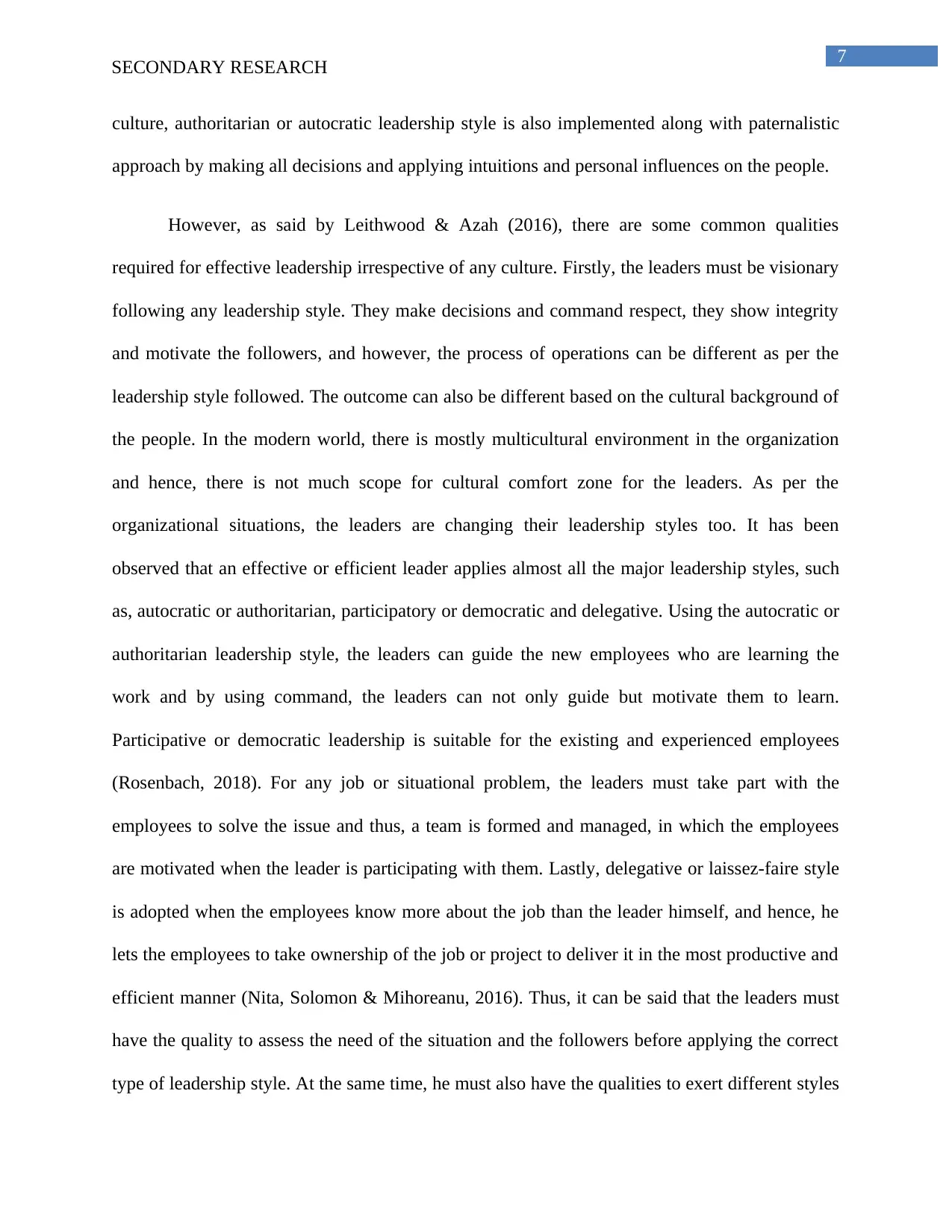
7
SECONDARY RESEARCH
culture, authoritarian or autocratic leadership style is also implemented along with paternalistic
approach by making all decisions and applying intuitions and personal influences on the people.
However, as said by Leithwood & Azah (2016), there are some common qualities
required for effective leadership irrespective of any culture. Firstly, the leaders must be visionary
following any leadership style. They make decisions and command respect, they show integrity
and motivate the followers, and however, the process of operations can be different as per the
leadership style followed. The outcome can also be different based on the cultural background of
the people. In the modern world, there is mostly multicultural environment in the organization
and hence, there is not much scope for cultural comfort zone for the leaders. As per the
organizational situations, the leaders are changing their leadership styles too. It has been
observed that an effective or efficient leader applies almost all the major leadership styles, such
as, autocratic or authoritarian, participatory or democratic and delegative. Using the autocratic or
authoritarian leadership style, the leaders can guide the new employees who are learning the
work and by using command, the leaders can not only guide but motivate them to learn.
Participative or democratic leadership is suitable for the existing and experienced employees
(Rosenbach, 2018). For any job or situational problem, the leaders must take part with the
employees to solve the issue and thus, a team is formed and managed, in which the employees
are motivated when the leader is participating with them. Lastly, delegative or laissez-faire style
is adopted when the employees know more about the job than the leader himself, and hence, he
lets the employees to take ownership of the job or project to deliver it in the most productive and
efficient manner (Nita, Solomon & Mihoreanu, 2016). Thus, it can be said that the leaders must
have the quality to assess the need of the situation and the followers before applying the correct
type of leadership style. At the same time, he must also have the qualities to exert different styles
SECONDARY RESEARCH
culture, authoritarian or autocratic leadership style is also implemented along with paternalistic
approach by making all decisions and applying intuitions and personal influences on the people.
However, as said by Leithwood & Azah (2016), there are some common qualities
required for effective leadership irrespective of any culture. Firstly, the leaders must be visionary
following any leadership style. They make decisions and command respect, they show integrity
and motivate the followers, and however, the process of operations can be different as per the
leadership style followed. The outcome can also be different based on the cultural background of
the people. In the modern world, there is mostly multicultural environment in the organization
and hence, there is not much scope for cultural comfort zone for the leaders. As per the
organizational situations, the leaders are changing their leadership styles too. It has been
observed that an effective or efficient leader applies almost all the major leadership styles, such
as, autocratic or authoritarian, participatory or democratic and delegative. Using the autocratic or
authoritarian leadership style, the leaders can guide the new employees who are learning the
work and by using command, the leaders can not only guide but motivate them to learn.
Participative or democratic leadership is suitable for the existing and experienced employees
(Rosenbach, 2018). For any job or situational problem, the leaders must take part with the
employees to solve the issue and thus, a team is formed and managed, in which the employees
are motivated when the leader is participating with them. Lastly, delegative or laissez-faire style
is adopted when the employees know more about the job than the leader himself, and hence, he
lets the employees to take ownership of the job or project to deliver it in the most productive and
efficient manner (Nita, Solomon & Mihoreanu, 2016). Thus, it can be said that the leaders must
have the quality to assess the need of the situation and the followers before applying the correct
type of leadership style. At the same time, he must also have the qualities to exert different styles
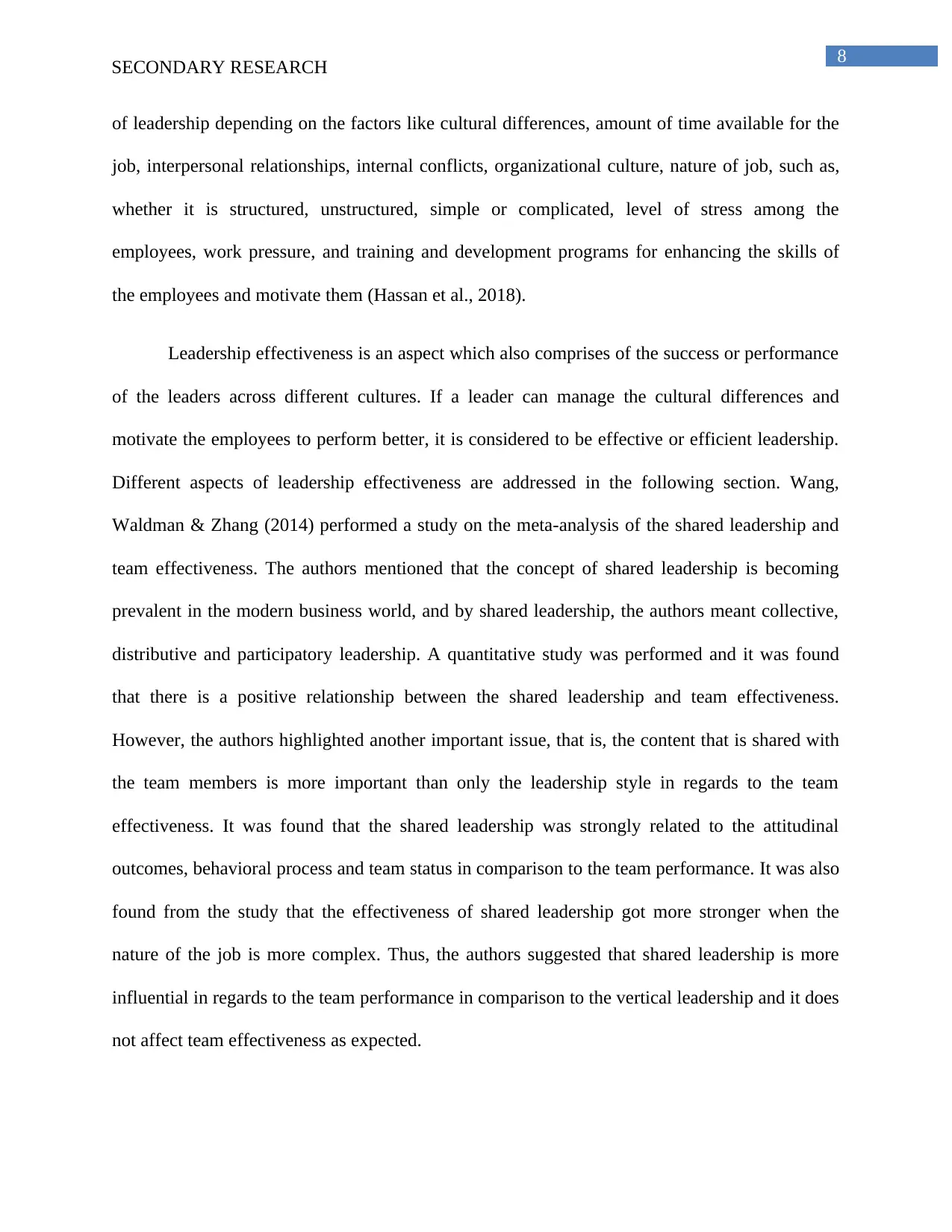
8
SECONDARY RESEARCH
of leadership depending on the factors like cultural differences, amount of time available for the
job, interpersonal relationships, internal conflicts, organizational culture, nature of job, such as,
whether it is structured, unstructured, simple or complicated, level of stress among the
employees, work pressure, and training and development programs for enhancing the skills of
the employees and motivate them (Hassan et al., 2018).
Leadership effectiveness is an aspect which also comprises of the success or performance
of the leaders across different cultures. If a leader can manage the cultural differences and
motivate the employees to perform better, it is considered to be effective or efficient leadership.
Different aspects of leadership effectiveness are addressed in the following section. Wang,
Waldman & Zhang (2014) performed a study on the meta-analysis of the shared leadership and
team effectiveness. The authors mentioned that the concept of shared leadership is becoming
prevalent in the modern business world, and by shared leadership, the authors meant collective,
distributive and participatory leadership. A quantitative study was performed and it was found
that there is a positive relationship between the shared leadership and team effectiveness.
However, the authors highlighted another important issue, that is, the content that is shared with
the team members is more important than only the leadership style in regards to the team
effectiveness. It was found that the shared leadership was strongly related to the attitudinal
outcomes, behavioral process and team status in comparison to the team performance. It was also
found from the study that the effectiveness of shared leadership got more stronger when the
nature of the job is more complex. Thus, the authors suggested that shared leadership is more
influential in regards to the team performance in comparison to the vertical leadership and it does
not affect team effectiveness as expected.
SECONDARY RESEARCH
of leadership depending on the factors like cultural differences, amount of time available for the
job, interpersonal relationships, internal conflicts, organizational culture, nature of job, such as,
whether it is structured, unstructured, simple or complicated, level of stress among the
employees, work pressure, and training and development programs for enhancing the skills of
the employees and motivate them (Hassan et al., 2018).
Leadership effectiveness is an aspect which also comprises of the success or performance
of the leaders across different cultures. If a leader can manage the cultural differences and
motivate the employees to perform better, it is considered to be effective or efficient leadership.
Different aspects of leadership effectiveness are addressed in the following section. Wang,
Waldman & Zhang (2014) performed a study on the meta-analysis of the shared leadership and
team effectiveness. The authors mentioned that the concept of shared leadership is becoming
prevalent in the modern business world, and by shared leadership, the authors meant collective,
distributive and participatory leadership. A quantitative study was performed and it was found
that there is a positive relationship between the shared leadership and team effectiveness.
However, the authors highlighted another important issue, that is, the content that is shared with
the team members is more important than only the leadership style in regards to the team
effectiveness. It was found that the shared leadership was strongly related to the attitudinal
outcomes, behavioral process and team status in comparison to the team performance. It was also
found from the study that the effectiveness of shared leadership got more stronger when the
nature of the job is more complex. Thus, the authors suggested that shared leadership is more
influential in regards to the team performance in comparison to the vertical leadership and it does
not affect team effectiveness as expected.
⊘ This is a preview!⊘
Do you want full access?
Subscribe today to unlock all pages.

Trusted by 1+ million students worldwide
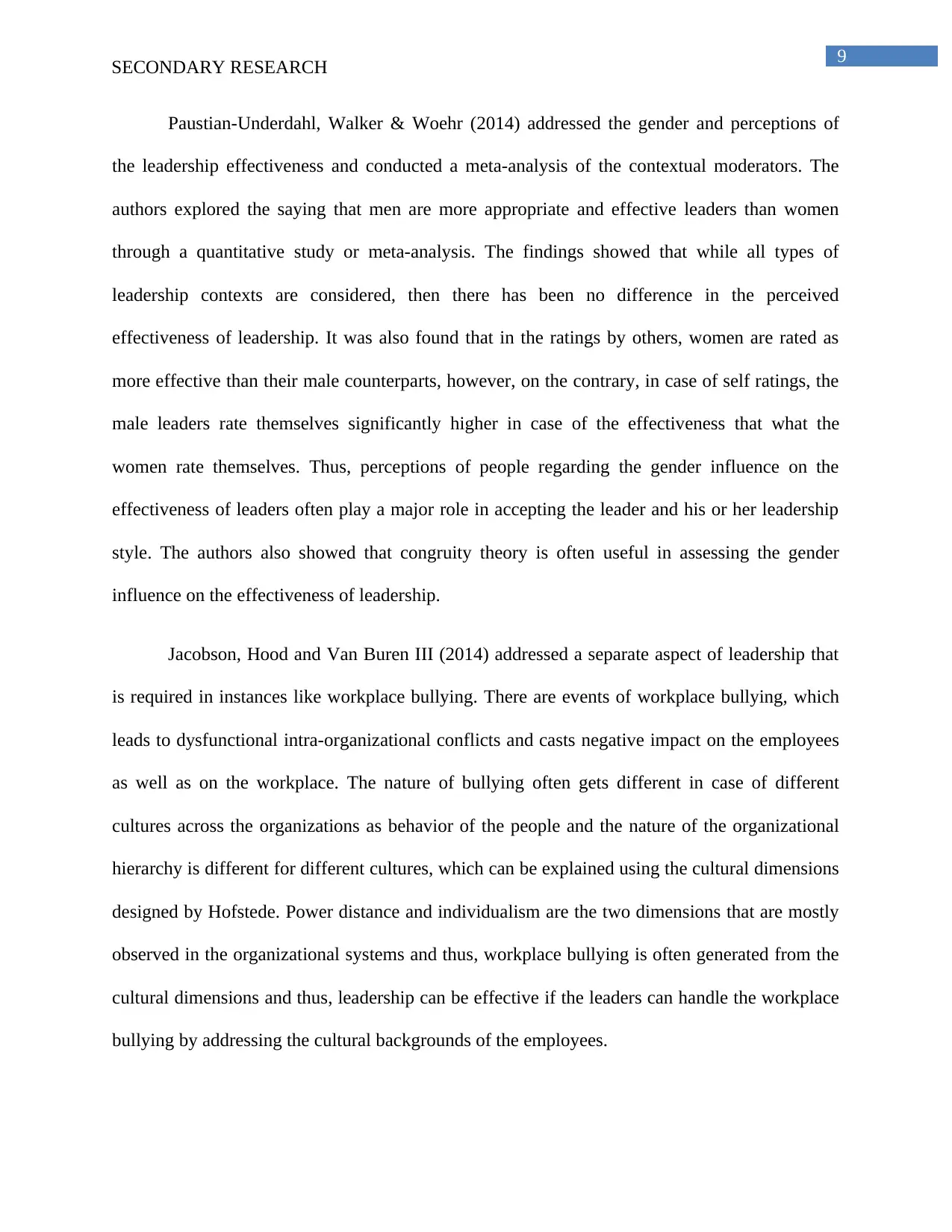
9
SECONDARY RESEARCH
Paustian-Underdahl, Walker & Woehr (2014) addressed the gender and perceptions of
the leadership effectiveness and conducted a meta-analysis of the contextual moderators. The
authors explored the saying that men are more appropriate and effective leaders than women
through a quantitative study or meta-analysis. The findings showed that while all types of
leadership contexts are considered, then there has been no difference in the perceived
effectiveness of leadership. It was also found that in the ratings by others, women are rated as
more effective than their male counterparts, however, on the contrary, in case of self ratings, the
male leaders rate themselves significantly higher in case of the effectiveness that what the
women rate themselves. Thus, perceptions of people regarding the gender influence on the
effectiveness of leaders often play a major role in accepting the leader and his or her leadership
style. The authors also showed that congruity theory is often useful in assessing the gender
influence on the effectiveness of leadership.
Jacobson, Hood and Van Buren III (2014) addressed a separate aspect of leadership that
is required in instances like workplace bullying. There are events of workplace bullying, which
leads to dysfunctional intra-organizational conflicts and casts negative impact on the employees
as well as on the workplace. The nature of bullying often gets different in case of different
cultures across the organizations as behavior of the people and the nature of the organizational
hierarchy is different for different cultures, which can be explained using the cultural dimensions
designed by Hofstede. Power distance and individualism are the two dimensions that are mostly
observed in the organizational systems and thus, workplace bullying is often generated from the
cultural dimensions and thus, leadership can be effective if the leaders can handle the workplace
bullying by addressing the cultural backgrounds of the employees.
SECONDARY RESEARCH
Paustian-Underdahl, Walker & Woehr (2014) addressed the gender and perceptions of
the leadership effectiveness and conducted a meta-analysis of the contextual moderators. The
authors explored the saying that men are more appropriate and effective leaders than women
through a quantitative study or meta-analysis. The findings showed that while all types of
leadership contexts are considered, then there has been no difference in the perceived
effectiveness of leadership. It was also found that in the ratings by others, women are rated as
more effective than their male counterparts, however, on the contrary, in case of self ratings, the
male leaders rate themselves significantly higher in case of the effectiveness that what the
women rate themselves. Thus, perceptions of people regarding the gender influence on the
effectiveness of leaders often play a major role in accepting the leader and his or her leadership
style. The authors also showed that congruity theory is often useful in assessing the gender
influence on the effectiveness of leadership.
Jacobson, Hood and Van Buren III (2014) addressed a separate aspect of leadership that
is required in instances like workplace bullying. There are events of workplace bullying, which
leads to dysfunctional intra-organizational conflicts and casts negative impact on the employees
as well as on the workplace. The nature of bullying often gets different in case of different
cultures across the organizations as behavior of the people and the nature of the organizational
hierarchy is different for different cultures, which can be explained using the cultural dimensions
designed by Hofstede. Power distance and individualism are the two dimensions that are mostly
observed in the organizational systems and thus, workplace bullying is often generated from the
cultural dimensions and thus, leadership can be effective if the leaders can handle the workplace
bullying by addressing the cultural backgrounds of the employees.
Paraphrase This Document
Need a fresh take? Get an instant paraphrase of this document with our AI Paraphraser
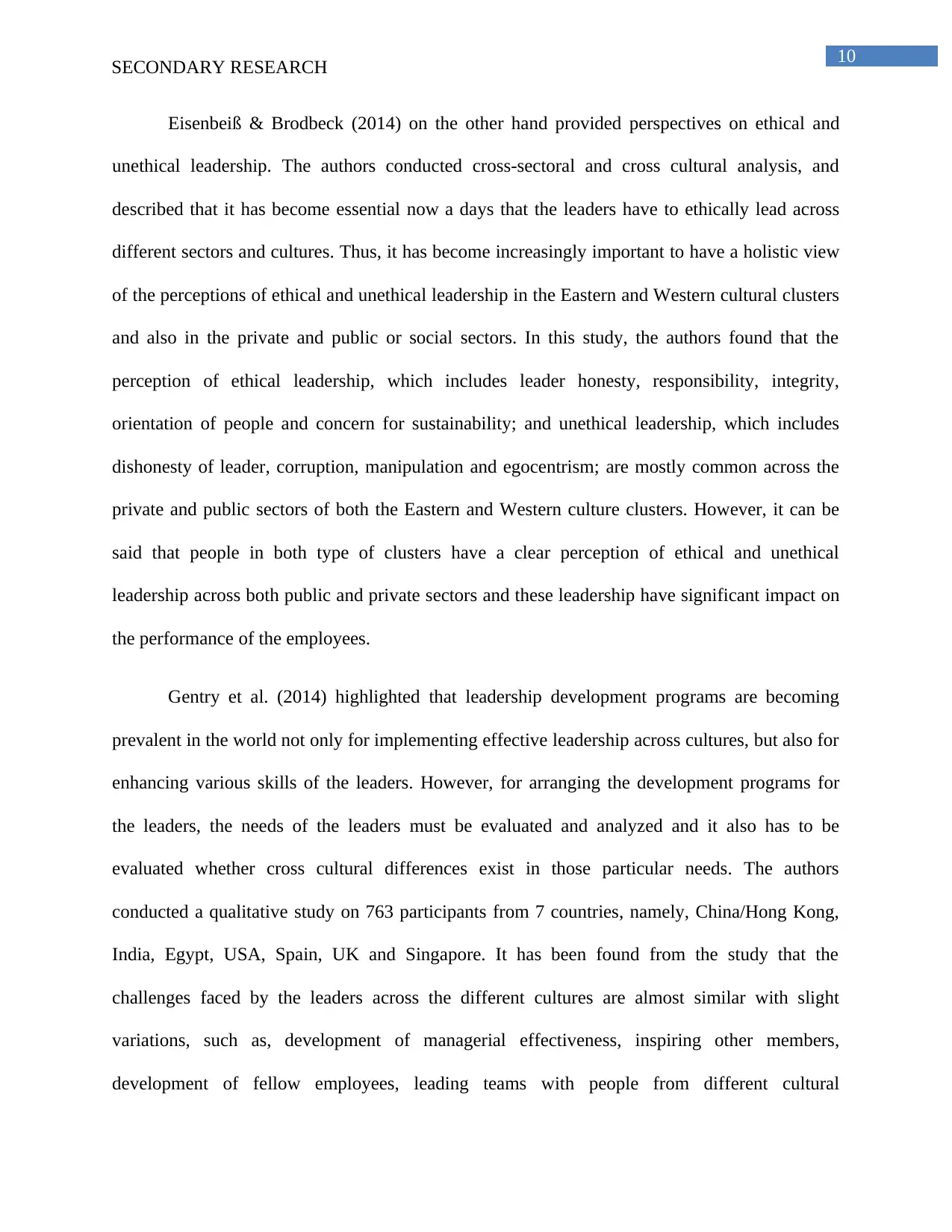
10
SECONDARY RESEARCH
Eisenbeiß & Brodbeck (2014) on the other hand provided perspectives on ethical and
unethical leadership. The authors conducted cross-sectoral and cross cultural analysis, and
described that it has become essential now a days that the leaders have to ethically lead across
different sectors and cultures. Thus, it has become increasingly important to have a holistic view
of the perceptions of ethical and unethical leadership in the Eastern and Western cultural clusters
and also in the private and public or social sectors. In this study, the authors found that the
perception of ethical leadership, which includes leader honesty, responsibility, integrity,
orientation of people and concern for sustainability; and unethical leadership, which includes
dishonesty of leader, corruption, manipulation and egocentrism; are mostly common across the
private and public sectors of both the Eastern and Western culture clusters. However, it can be
said that people in both type of clusters have a clear perception of ethical and unethical
leadership across both public and private sectors and these leadership have significant impact on
the performance of the employees.
Gentry et al. (2014) highlighted that leadership development programs are becoming
prevalent in the world not only for implementing effective leadership across cultures, but also for
enhancing various skills of the leaders. However, for arranging the development programs for
the leaders, the needs of the leaders must be evaluated and analyzed and it also has to be
evaluated whether cross cultural differences exist in those particular needs. The authors
conducted a qualitative study on 763 participants from 7 countries, namely, China/Hong Kong,
India, Egypt, USA, Spain, UK and Singapore. It has been found from the study that the
challenges faced by the leaders across the different cultures are almost similar with slight
variations, such as, development of managerial effectiveness, inspiring other members,
development of fellow employees, leading teams with people from different cultural
SECONDARY RESEARCH
Eisenbeiß & Brodbeck (2014) on the other hand provided perspectives on ethical and
unethical leadership. The authors conducted cross-sectoral and cross cultural analysis, and
described that it has become essential now a days that the leaders have to ethically lead across
different sectors and cultures. Thus, it has become increasingly important to have a holistic view
of the perceptions of ethical and unethical leadership in the Eastern and Western cultural clusters
and also in the private and public or social sectors. In this study, the authors found that the
perception of ethical leadership, which includes leader honesty, responsibility, integrity,
orientation of people and concern for sustainability; and unethical leadership, which includes
dishonesty of leader, corruption, manipulation and egocentrism; are mostly common across the
private and public sectors of both the Eastern and Western culture clusters. However, it can be
said that people in both type of clusters have a clear perception of ethical and unethical
leadership across both public and private sectors and these leadership have significant impact on
the performance of the employees.
Gentry et al. (2014) highlighted that leadership development programs are becoming
prevalent in the world not only for implementing effective leadership across cultures, but also for
enhancing various skills of the leaders. However, for arranging the development programs for
the leaders, the needs of the leaders must be evaluated and analyzed and it also has to be
evaluated whether cross cultural differences exist in those particular needs. The authors
conducted a qualitative study on 763 participants from 7 countries, namely, China/Hong Kong,
India, Egypt, USA, Spain, UK and Singapore. It has been found from the study that the
challenges faced by the leaders across the different cultures are almost similar with slight
variations, such as, development of managerial effectiveness, inspiring other members,
development of fellow employees, leading teams with people from different cultural
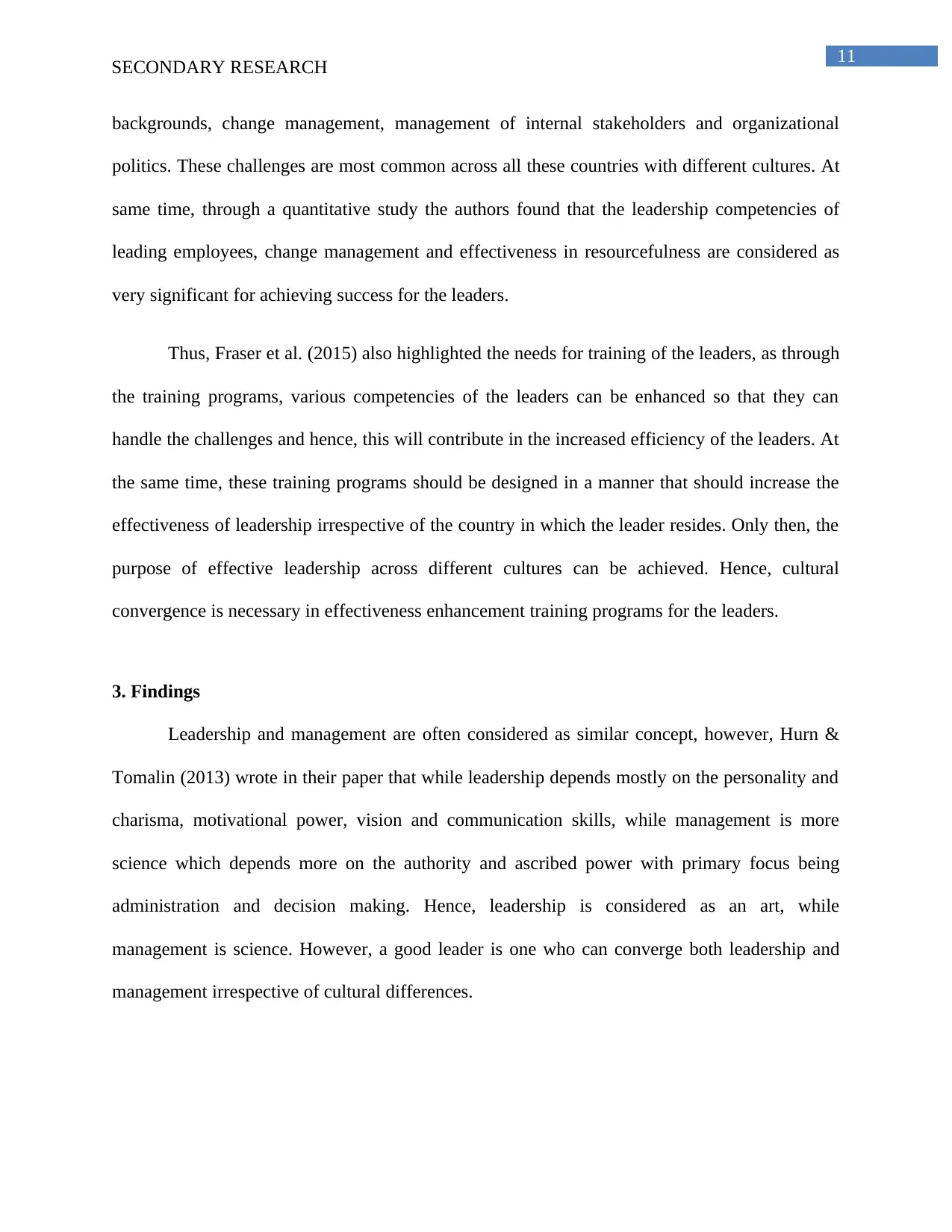
11
SECONDARY RESEARCH
backgrounds, change management, management of internal stakeholders and organizational
politics. These challenges are most common across all these countries with different cultures. At
same time, through a quantitative study the authors found that the leadership competencies of
leading employees, change management and effectiveness in resourcefulness are considered as
very significant for achieving success for the leaders.
Thus, Fraser et al. (2015) also highlighted the needs for training of the leaders, as through
the training programs, various competencies of the leaders can be enhanced so that they can
handle the challenges and hence, this will contribute in the increased efficiency of the leaders. At
the same time, these training programs should be designed in a manner that should increase the
effectiveness of leadership irrespective of the country in which the leader resides. Only then, the
purpose of effective leadership across different cultures can be achieved. Hence, cultural
convergence is necessary in effectiveness enhancement training programs for the leaders.
3. Findings
Leadership and management are often considered as similar concept, however, Hurn &
Tomalin (2013) wrote in their paper that while leadership depends mostly on the personality and
charisma, motivational power, vision and communication skills, while management is more
science which depends more on the authority and ascribed power with primary focus being
administration and decision making. Hence, leadership is considered as an art, while
management is science. However, a good leader is one who can converge both leadership and
management irrespective of cultural differences.
SECONDARY RESEARCH
backgrounds, change management, management of internal stakeholders and organizational
politics. These challenges are most common across all these countries with different cultures. At
same time, through a quantitative study the authors found that the leadership competencies of
leading employees, change management and effectiveness in resourcefulness are considered as
very significant for achieving success for the leaders.
Thus, Fraser et al. (2015) also highlighted the needs for training of the leaders, as through
the training programs, various competencies of the leaders can be enhanced so that they can
handle the challenges and hence, this will contribute in the increased efficiency of the leaders. At
the same time, these training programs should be designed in a manner that should increase the
effectiveness of leadership irrespective of the country in which the leader resides. Only then, the
purpose of effective leadership across different cultures can be achieved. Hence, cultural
convergence is necessary in effectiveness enhancement training programs for the leaders.
3. Findings
Leadership and management are often considered as similar concept, however, Hurn &
Tomalin (2013) wrote in their paper that while leadership depends mostly on the personality and
charisma, motivational power, vision and communication skills, while management is more
science which depends more on the authority and ascribed power with primary focus being
administration and decision making. Hence, leadership is considered as an art, while
management is science. However, a good leader is one who can converge both leadership and
management irrespective of cultural differences.
⊘ This is a preview!⊘
Do you want full access?
Subscribe today to unlock all pages.

Trusted by 1+ million students worldwide
1 out of 20
Related Documents
Your All-in-One AI-Powered Toolkit for Academic Success.
+13062052269
info@desklib.com
Available 24*7 on WhatsApp / Email
![[object Object]](/_next/static/media/star-bottom.7253800d.svg)
Unlock your academic potential
Copyright © 2020–2025 A2Z Services. All Rights Reserved. Developed and managed by ZUCOL.





